Effect of Dynamic Preheating on the Thermal Behavior and Mechanical Properties of Laser-Welded Joints
Abstract
:1. Introduction
2. Experimental Procedure
2.1. Experimental Methods and Equipment
2.2. Numerical Simulation
3. Results and Discussion
3.1. Temperature Test
3.2. Temperature Distribution
3.3. Hardness and Mechanical Properties
4. Conclusions
- (1)
- The FEM of dynamic preheating LW was successfully established, and the accuracy of the model was verified by experiments. The simulation results were in good agreement with the experimental results. Under the action of arc dynamic preheating, the molten pool area increases significantly;
- (2)
- Under the action of arc dynamic preheating, the temperature gradient and cooling rate of HLAW were significantly lower than those of LW. Changing the current level has a certain influence on the temperature gradient. Excessive current (40 A) leads to a significant decrease in the temperature gradient of the preheating temperature rise. However, the change in current has a negligible effect on the cooling rate;
- (3)
- Arc dynamic preheating is conducive to improving the hardness and tensile properties of welded joints due to ferrite refinement after dynamic preheating. Feathery ferrite forms at appropriate preheating temperature. Compared with values from LW, the yield strength of welded joints with dynamic preheating by a current of 20 A increased by 18.3%, from 477.0 to 564.3 MPa. The use of the appropriate current is helpful in reducing thermal stress and improving the tensile properties of the joint.
Author Contributions
Funding
Institutional Review Board Statement
Informed Consent Statement
Data Availability Statement
Conflicts of Interest
References
- Tembhurkar, C.; Kataria, R.; Ambade, S.; Verma, J.; Sharma, A.; Sarkar, S. Effect of fillers and autogenous welding on dissimilar welded 316L austenitic and 430 ferritic stainless steels. J. Mater. Eng. Perform. 2021, 30, 1444–1453. [Google Scholar] [CrossRef]
- Thomas, M.; Prakash, R.V.; Ganesh Sundara Raman, S.; Vasudevan, M. High temperature fatigue crack growth rate studies in stainless steel 316L(N) welds processed by A-TIG and MP-TIG welding. MATEC Web Conf. 2018, 165, 21014. [Google Scholar] [CrossRef]
- Wu, S.; Xiao, R. Effect of high power CO2 and Yb:YAG laser radiation on the characteristics of TIG Arc in atmospherical pressure Argon and Helium. Opt. Laser Technol. 2015, 67, 169–175. [Google Scholar] [CrossRef]
- Piekarska, W.; Kubiak, M. Modeling of thermal phenomena in single laser beam and laser-Arc hybrid welding processes using projection method. Appl. Math. Model. 2013, 37, 2051–2062. [Google Scholar] [CrossRef]
- Ding, J.; Colegrove, P.; Mehnen, J.; Williams, S.; Wang, F.; Almeida, P.S. A computationally efficient finite element model of wire and Arc additive manufacture. Int. J. Adv. Manuf. Technol. 2014, 70, 227–236. [Google Scholar] [CrossRef]
- Kubra, K.; Alaa, E.; Gustavo, T.; Brian, F.; Luke, J.; Ji, M.; Ibrahim, K.; Raymundo, A. Numerical and experimental analysis of heat distribution in the laser powder bed fusion of Ti-6Al-4V. IISE Trans. 2019, 51, 136–152. [Google Scholar] [CrossRef]
- Chelladurai Asirvatham, M.; Collins, S.; Masters, I. Laser wobble welding of steel to aluminium busbar joints for Li-ion battery packs. Opt. Laser Technol. 2022, 151, 108000. [Google Scholar] [CrossRef]
- Li, Q.; Luo, M.; Mu, Z.; Huang, A.; Pang, S. Improving laser lelding via decreasing central beam density with a hollow beam. J. Manuf. Processes 2022, 73, 939–947. [Google Scholar] [CrossRef]
- Xiong, J.; Lei, Y.; Li, R. Finite element analysis and experimental validation of thermal behavior for thin-walled parts in GMAW-based additive manufacturing with various substrate preheating temperatures. Appl. Therm. Eng. 2017, 126, 43–52. [Google Scholar] [CrossRef]
- Wu, T.; Shi, W.; Xie, L.; Gong, M.; Huang, J.; Xie, Y.; He, K. Effect of preheating temperature on geometry and mechanical properties of laser cladding-based stellite 6/WC coating. Materials 2022, 15, 3952. [Google Scholar] [CrossRef]
- Huang, Y.; Zeng, X. Investigation on cracking behavior of Ni-based coating by laser-induction hybrid cladding. Appl. Surf. Sci. 2010, 256, 5985–5992. [Google Scholar] [CrossRef]
- Liu, H.; Du, X.; Guo, H.; Liu, J.; Chen, P.; Yang, H.; Hao, J. Finite element analysis of effects of dynamic preheating on thermal behavior of multi-track and multi-layer laser cladding. Optik 2021, 228, 166194. [Google Scholar] [CrossRef]
- Shen, J.; Li, B.; Hu, S.; Zhang, H.; Bu, X. Comparison of single-beam and dual-beam laser welding of Ti–22Al–25Nb/TA15 dissimilar titanium alloys. Opt. Laser Technol. 2017, 93, 118–126. [Google Scholar] [CrossRef]
- Mahrle, A.; Rose, S.; Schnick, M.; Beyer, E.; Füssel, U. Stabilisation of plasma welding Arcs by low power laser beams. Sci. Technol. Weld. Joi. 2013, 18, 323–328. [Google Scholar] [CrossRef]
- Mu, Z.; Chen, X.; Zheng, Z.; Huang, A.; Pang, S. Laser cooling Arc plasma effect in laser-Arc hybrid welding of 316L stainless steel. Int. J. Heat Mass Transf. 2019, 132, 861–870. [Google Scholar] [CrossRef]
- Jiang, F.; Wang, S.; Xu, B.; Cheng, W.; Ma, X.; Chen, S. Local energy adjustment mechanism in a novel laser-enhanced plasma Arc heat source. Int. J. Therm. Sci. 2021, 168, 107081. [Google Scholar] [CrossRef]
- Gao, J.; Wu, C.; Hao, Y.; Xu, X.; Guo, L. Numerical simulation and experimental investigation on three-dimensional modelling of single-track geometry and temperature evolution by laser cladding. Opt. Laser Technol. 2020, 129, 106287. [Google Scholar] [CrossRef]
- Chen, L.; Mi, G.; Zhang, X.; Wang, C. Numerical and experimental investigation on microstructure and residual stress of multi-pass hybrid laser-Arc welded 316L steel. Mater. Des. 2019, 168, 107653. [Google Scholar] [CrossRef]
- Zou, X.; Yan, Z.; Zou, K.; Liu, W.; Song, L.; Li, S.; Cha, L. Grain refinement by dynamic recrystallization during laser direct energy deposition of 316L stainless steel under thermal cycles. J. Manuf. Processes 2022, 76, 646–655. [Google Scholar] [CrossRef]
- Li, C.; Zhang, D.; Gao, X.; Gao, H.; Han, X. Numerical simulation method of the multi-field coupling mechanism for laser cladding 316L powder. Weld. World 2022, 66, 423–440. [Google Scholar] [CrossRef]
- Rong, Y.; Huang, Y.; Xu, J.; Zheng, H.; Zhang, G. Numerical simulation and experiment analysis of angular distortion and residual stress in hybrid laser-magnetic welding. J. Mater. Process. Technol. 2017, 245, 270–277. [Google Scholar] [CrossRef]
- Zhen, W.; Li, H.; Wang, Q. Simulation of residual stress in aluminum alloy welding seam based on computer numerical simulation. Optik 2022, 258, 168785. [Google Scholar] [CrossRef]
- Silva, R.; Madureira, R.; Silva, J.; Soares, R.; Reis, A.; Neto, R.; Viana, F.; Emadinia, O.; Silva, R. Numerical simulation and defect identification in the casting of Co-Cr alloy. Metals 2022, 12, 351. [Google Scholar] [CrossRef]
- Mahrle, A.; Beyer, E. Hybrid laser beam welding—classification, characteristics, and applications. J. Laser Appl. 2006, 18, 169–180. [Google Scholar] [CrossRef]
- Saternus, Z.; Piekarska, W.; Sapieta, M.; Kopas, P. Numerical and experimental analysis of a laser welded joint made of dissimilar materials S355 and 304 steel. IOP Conf. Ser. Mater. Sci. Eng. 2020, 776, 012075. [Google Scholar] [CrossRef]
- Yang, Z.; Fang, Y.; He, J. Numerical simulation of heat transfer and fluid flow during vacuum electron beam welding of 2219 aluminium girth joints. Vacuum 2020, 175, 109256. [Google Scholar] [CrossRef]
- Ahmad, S.N.; Manurung, Y.H.P.; Prajadhiana, K.P.; Busari, Y.O.; Mat, M.F.; Muhammad, N.; Leitner, M.; Saidin, S. Numerical modelling and experimental analysis on angular strain induced by bead-on-plate SS316L GMAW using inherent strain and thermomechanical methods. Int. J. Adv. Manuf. Technol. 2022, 120, 627–644. [Google Scholar] [CrossRef]
- Petrov, P.; Tongov, M. Numerical modelling of heat source during electron beam welding. Vacuum 2020, 171, 108991. [Google Scholar] [CrossRef]
- Liu, L.; Huang, M.; Ma, Y.H.; Qin, M.L.; Liu, T.T. Simulation of powder packing and thermo-fluid dynamic of 316L stainless steel by selective laser melting. J. Mater. Eng. Perform. 2020, 29, 7369–7381. [Google Scholar] [CrossRef]
- Maurin, A. Numerical investigation of degradation of 316L steel caused by cavitation. Materials 2021, 14, 3131. [Google Scholar] [CrossRef]
- Rubenchik, A.; Wu, S.; Mitchell, S.; Golosker, I.; LeBlanc, M.; Peterson, N. Direct measurements of temperature-dependent laser absorptivity of metal powders. Appl. Opt. 2015, 54, 7230–7233. [Google Scholar] [CrossRef] [PubMed]
- Masmoudi, A.; Bolot, R.; Coddet, C. Investigation of the laser–powder–atmosphere interaction zone during the selective laser melting process. J. Mater. Processing Technol. 2015, 225, 122–132. [Google Scholar] [CrossRef]
- Zhang, H.; Wang, Y.; Han, T.; Bao, L.; Wu, Q.; Gu, S. Numerical and experimental investigation of the formation mechanism and the distribution of the welding residual stress induced by the hybrid laser Arc welding of AH36 steel in a butt joint configuration. J. Manuf. Processes 2020, 51, 95–108. [Google Scholar] [CrossRef]
- Lei, Z.; Zhu, Z.; Chen, H.; Li, Y. Fusion enhancement of hollow tungsten Arc coaxially assisted by fiber laser. Opt. Laser Technol. 2022, 150, 107905. [Google Scholar] [CrossRef]
- Cai, X.; Dong, B.; Lin, S.; Duan, S.; Ni, Z.; Hu, F. Keyhole TIG welding of 3-Mm-thick 10MnNiCr steel plates. Weld. World 2022, 66, 1349–1356. [Google Scholar] [CrossRef]
- Azevedo, S.C.; de Resende, A.A. Effect of angle, distance between electrodes and TIG current on the weld bead geometry in TIG-MIG/MAG welding process. Int. J. Adv. Manuf. Technol. 2021, 114, 1505–1515. [Google Scholar] [CrossRef]
- Zhao, Y.; You, J.; Qin, J.; Dong, C.; Liu, L.; Liu, Z.; Miao, S. Stationary shoulder friction stir welding of Al–Cu dissimilar materials and its mechanism for improving the microstructures and mechanical properties of joint. Mater. Sci. Eng. A 2022, 837, 142754. [Google Scholar] [CrossRef]
- Hu, Y.; Zhao, Y.; Peng, Y.; Yang, W.; Ma, X.; Wang, B. High-strength joint of nuclear-grade FeCrAl alloys achieved by friction stir welding and its strengthening mechanism. J. Manuf. Processes 2021, 65, 1–11. [Google Scholar] [CrossRef]
- Vadiraj, A.; Balachandran, G.; Kamaraj, M.; Gopalakrishna, B.; Prabhakara Rao, K. Structure–property correlation in austempered alloyed hypereutectic gray cast irons. Mater. Sci. Eng. A 2010, 527, 782–788. [Google Scholar] [CrossRef]
- Banavasi Shashidhar, M.; Ravishankar, K.S.; Naik Padmayya, S. Influence of high Mn-Cu-Mo on microstructure and fatigue characteristics of austempered ductile iron. IOP Conf. Series. Mater. Sci. Eng. 2018, 330, 012020. [Google Scholar] [CrossRef]
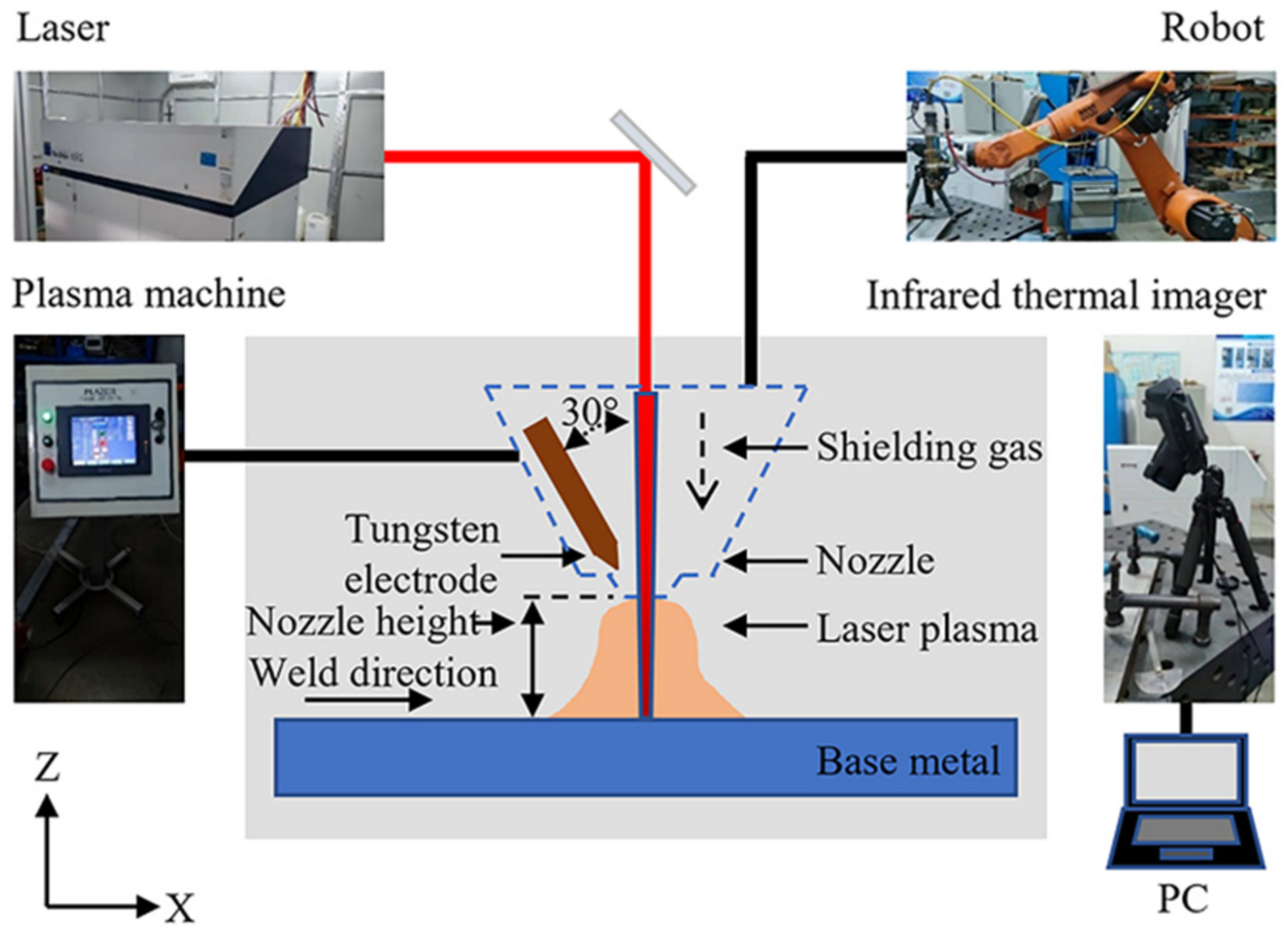

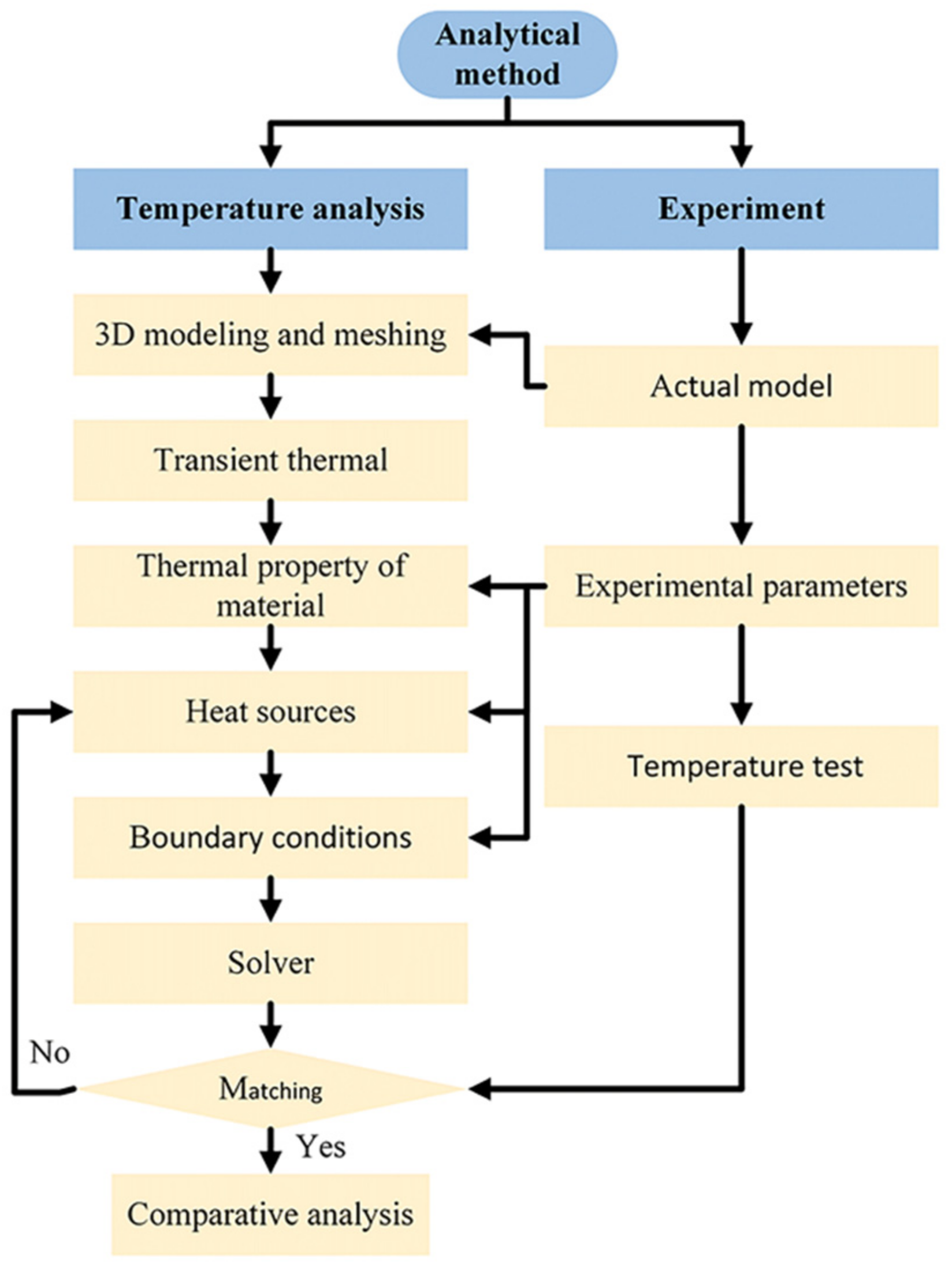
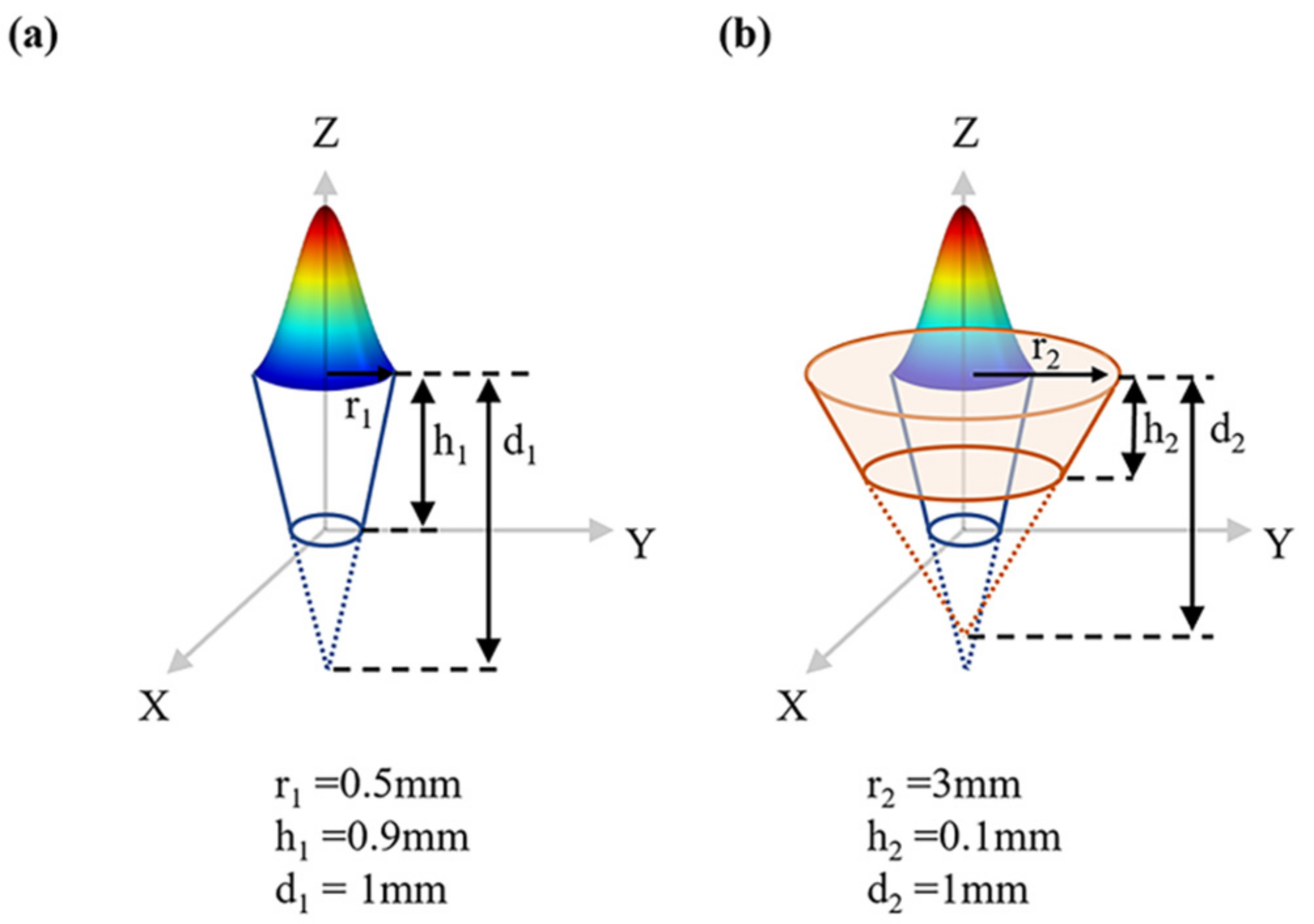
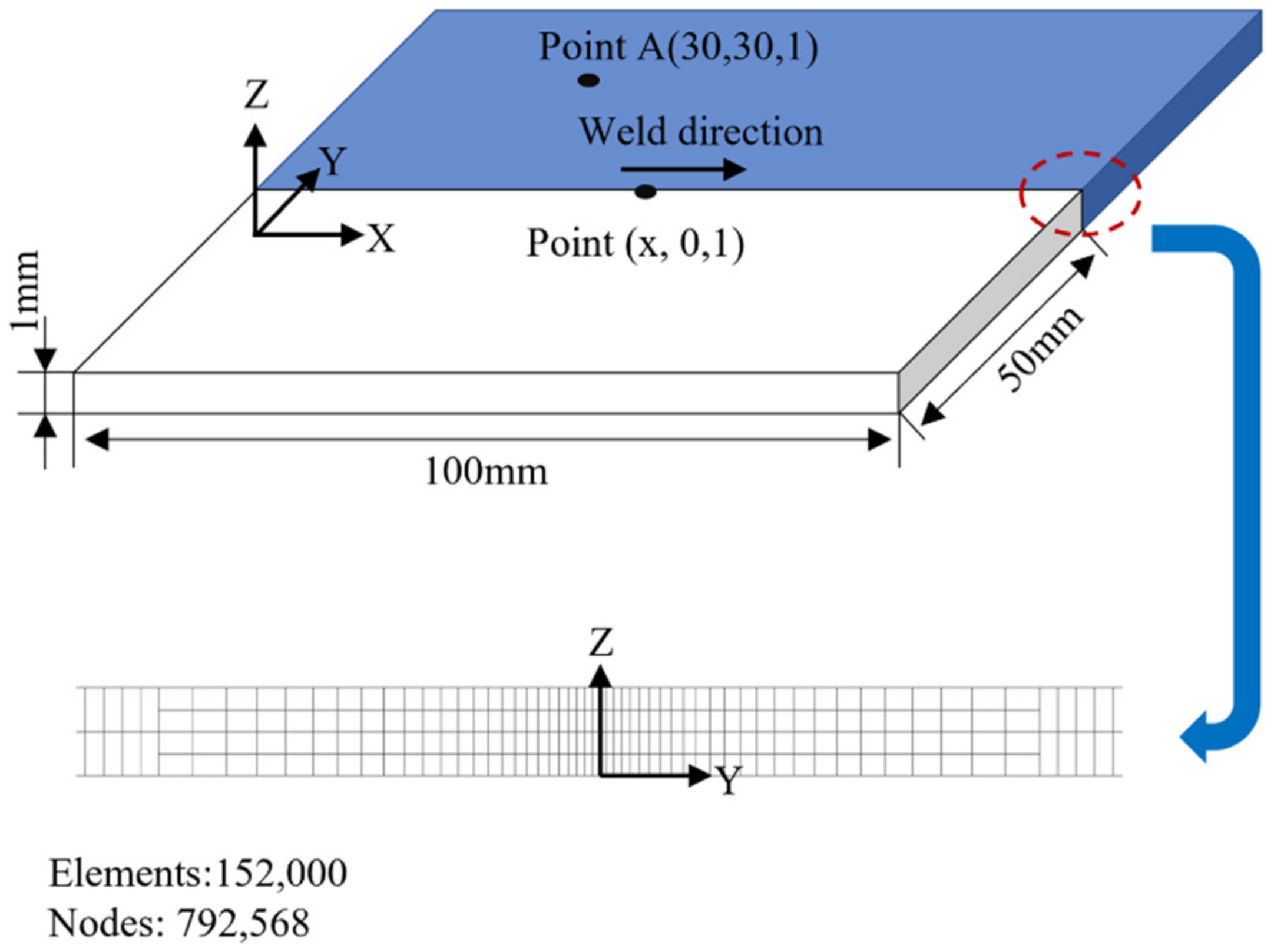

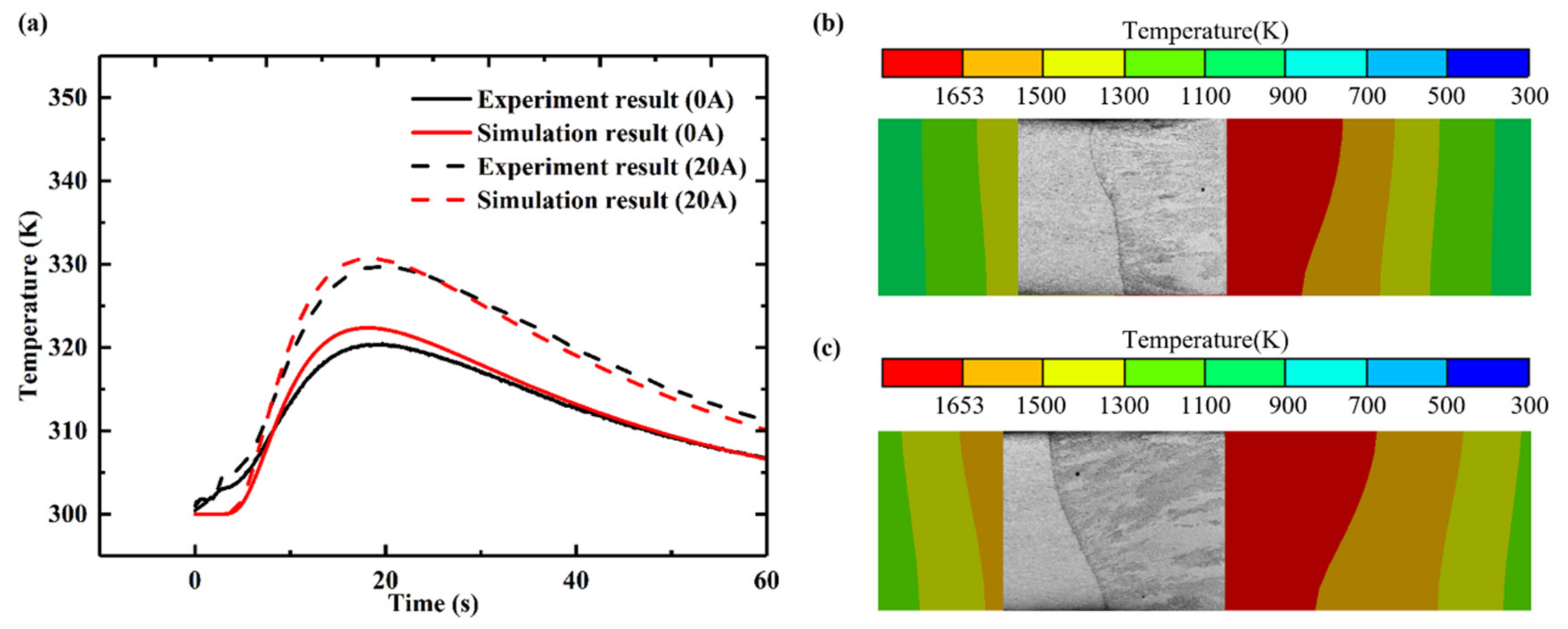


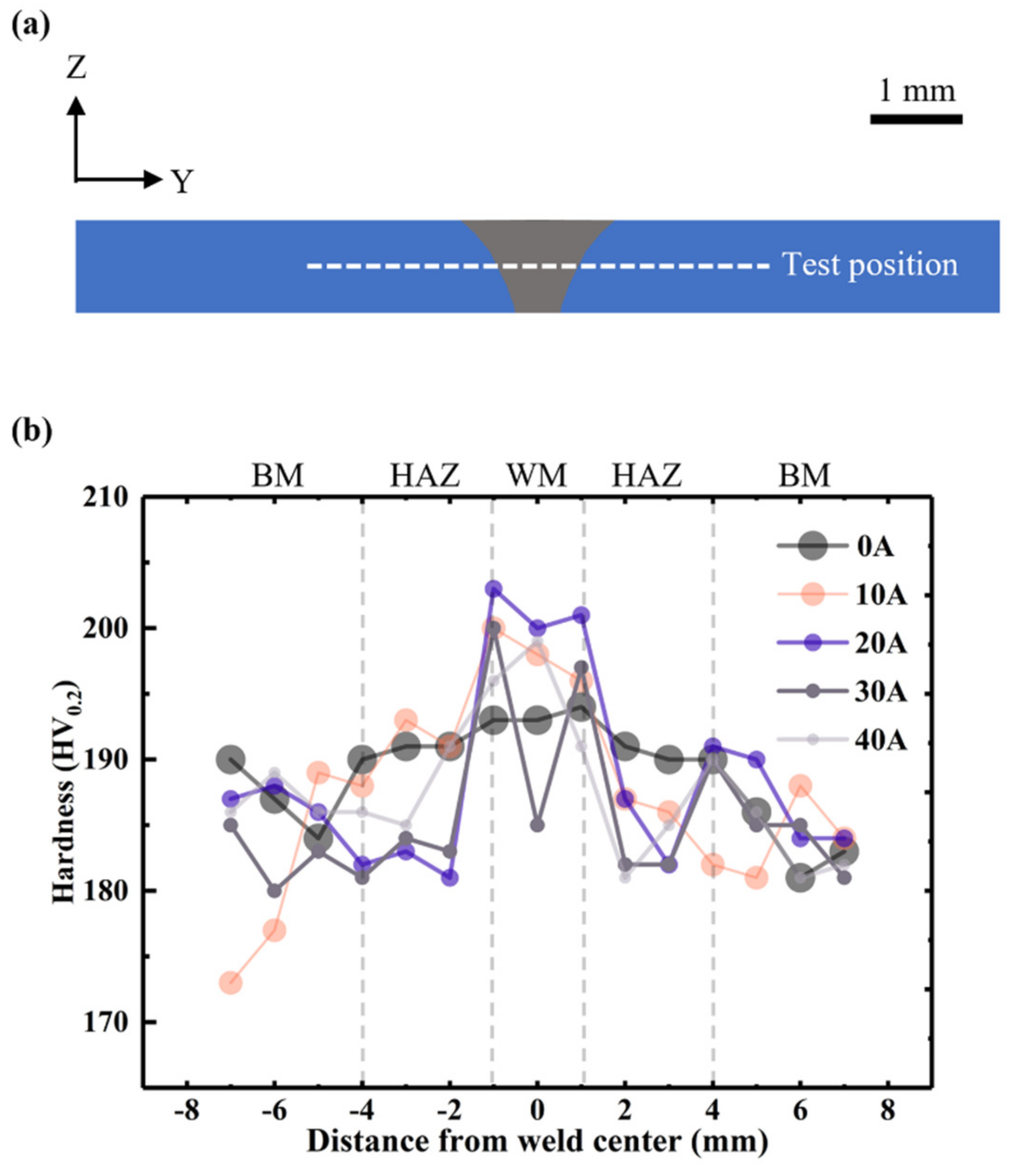
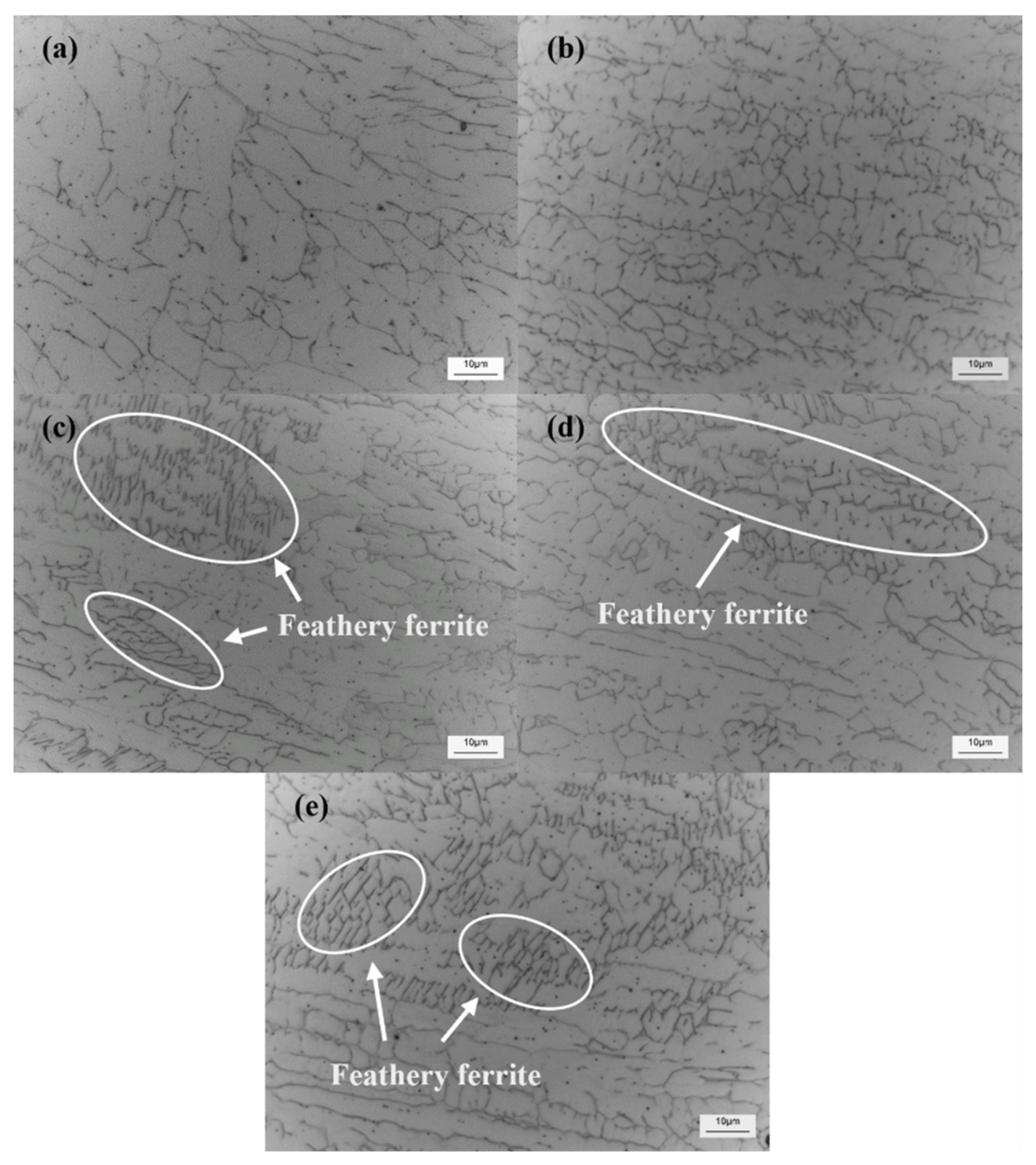


| Laser Characteristic Parameters | Value |
|---|---|
| maximum continuous output power | 10,000 W |
| Power output stability | ±1% |
| beam quality | 8 mm·mrad |
| laser wavelength | 1030 nm |
| Fiber diameter | 400 μm |
| Type | Fe | Si (%) | Mo (%) | Cr (%) | Ni (%) | Mn (%) |
|---|---|---|---|---|---|---|
| 316L | Balance | ≤1 | 2–3 | 16–18 | 12–15 | ≤2 |
| Case | 1 | 2 | 3 | 4 | 5 |
|---|---|---|---|---|---|
| Current (A) | 0 | 10 | 20 | 30 | 40 |
| Temperature (K) | Density (kg·m−3) | Specific Heat (J·kg−1·K−1) | Thermal Conductivity (W·m−1·K−1) |
|---|---|---|---|
| 300 | 7954 | 498.73 | 13.44 |
| 500 | 7864 | 525.51 | 16.8 |
| 700 | 7771 | 551.87 | 19.87 |
| 900 | 7674 | 578.65 | 22.79 |
| 1100 | 7574 | 605.01 | 25.46 |
| 1300 | 7471 | 631.78 | 28.02 |
| Nomenclature | Value |
|---|---|
| Ambient temperature | 300 K |
| Solidus temperature | 1653 K |
| Liquidus temperature | 1731 K |
| Gasification temperature | 3134 K |
| Latent heat of fusion | 2.77 × 105 K/kg |
| Latent heat of evaporation | 6.34 × 106 K/kg |
Publisher’s Note: MDPI stays neutral with regard to jurisdictional claims in published maps and institutional affiliations. |
© 2022 by the authors. Licensee MDPI, Basel, Switzerland. This article is an open access article distributed under the terms and conditions of the Creative Commons Attribution (CC BY) license (https://creativecommons.org/licenses/by/4.0/).
Share and Cite
Xie, L.; Shi, W.; Wu, T.; Gong, M.; Cai, D.; Han, S.; He, K. Effect of Dynamic Preheating on the Thermal Behavior and Mechanical Properties of Laser-Welded Joints. Materials 2022, 15, 6159. https://doi.org/10.3390/ma15176159
Xie L, Shi W, Wu T, Gong M, Cai D, Han S, He K. Effect of Dynamic Preheating on the Thermal Behavior and Mechanical Properties of Laser-Welded Joints. Materials. 2022; 15(17):6159. https://doi.org/10.3390/ma15176159
Chicago/Turabian StyleXie, Linyi, Wenqing Shi, Teng Wu, Meimei Gong, Detao Cai, Shanguo Han, and Kuanfang He. 2022. "Effect of Dynamic Preheating on the Thermal Behavior and Mechanical Properties of Laser-Welded Joints" Materials 15, no. 17: 6159. https://doi.org/10.3390/ma15176159





